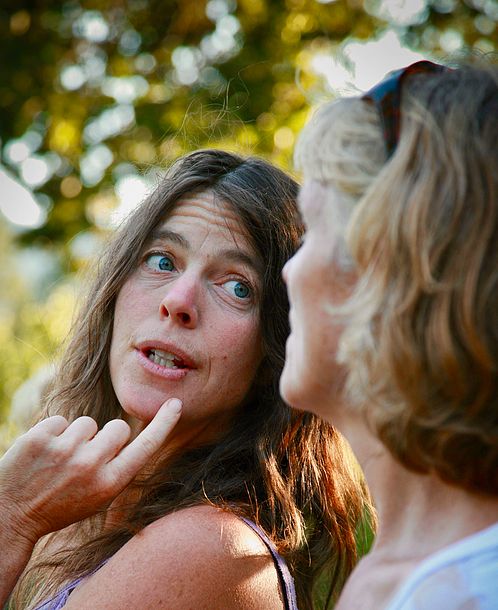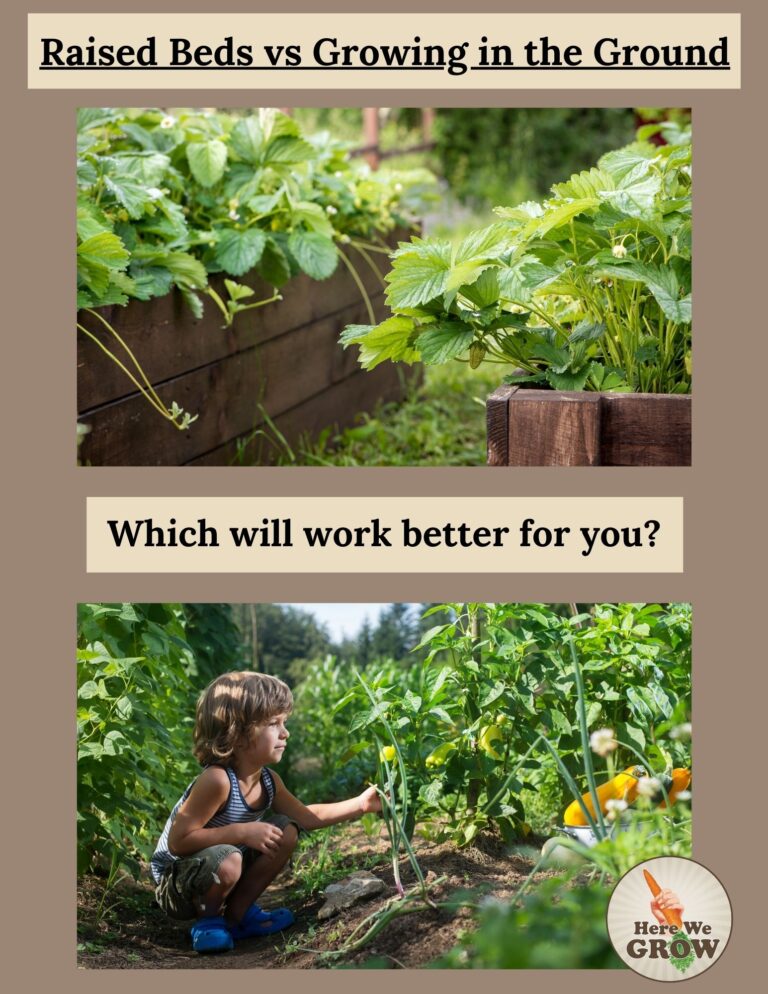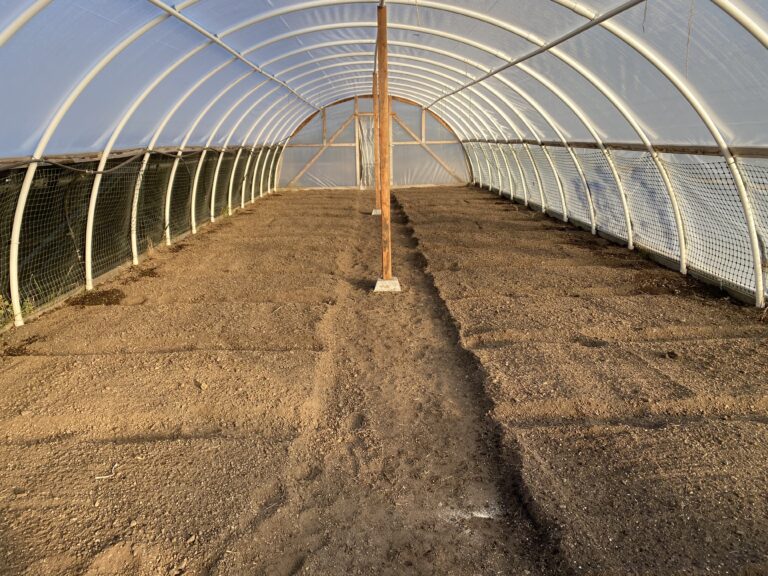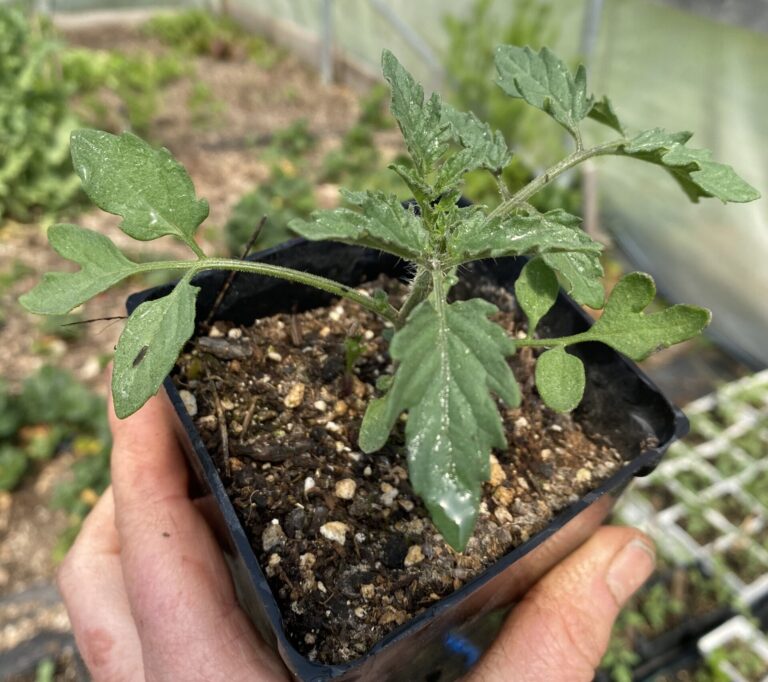How To Grow Huge Sunflowers with Edible Seeds
Many people grow sunflowers for their beauty alone. but sunflowers offer much more. One sunflower head can produce over 1,000 seeds, which can be used for eating, sprouting, planting, or to feed your poultry or livestock..
Sunflower seeds are high in protein, fiber, Vitamin E, Selenium and other essential nutrients. All varieties of sunflowers are edible, but larger, grey and white striped seeds are meatier and tastier than the smaller dark oilseed varieties. Try your hand at growing and harvesting the seeds.
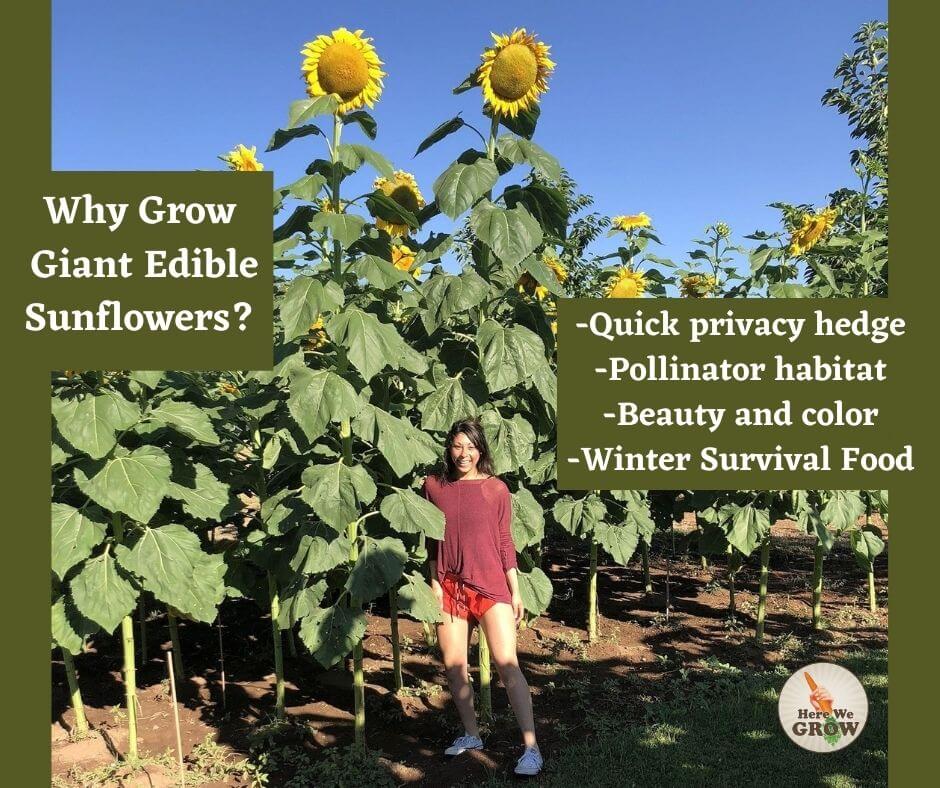
Giant Mammoth Sunflowers -Super Tall with plump, edible seeds
There are so many sunflower varieties (helianthus annuus) to choose from but my favorite is the ginormous Mammoth Sunflower (Mammoth Russian, Mammoth grey stripe, Mammoth Black seed). This giant sunflower is a fast grower, produce one flower per plant. The single stalk can reach 10-12′ tall and produces one 10″-12″ flower! The sheer size of this radiant flower towering overhead strikes awe into onlookers below.
This Sunflower provides spectacular golden beauty to your garden, then it gives you seeds for roasting and eating. This sunflower is very easy to grow, not fussy about soil and is drought tolerant. Grow in a tight row to make an attractive screen
Where do I get the seeds?
Here We Grow Gardens has our own Sunflower Seeds for sale in our shop. We have 2 Mammoth Varieties
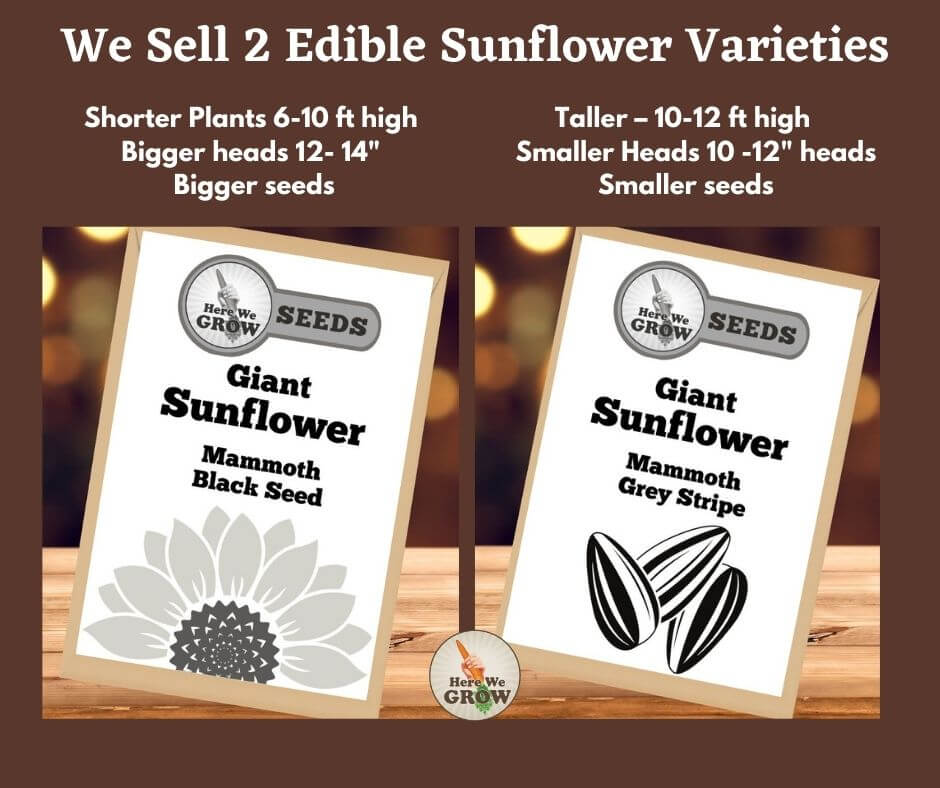
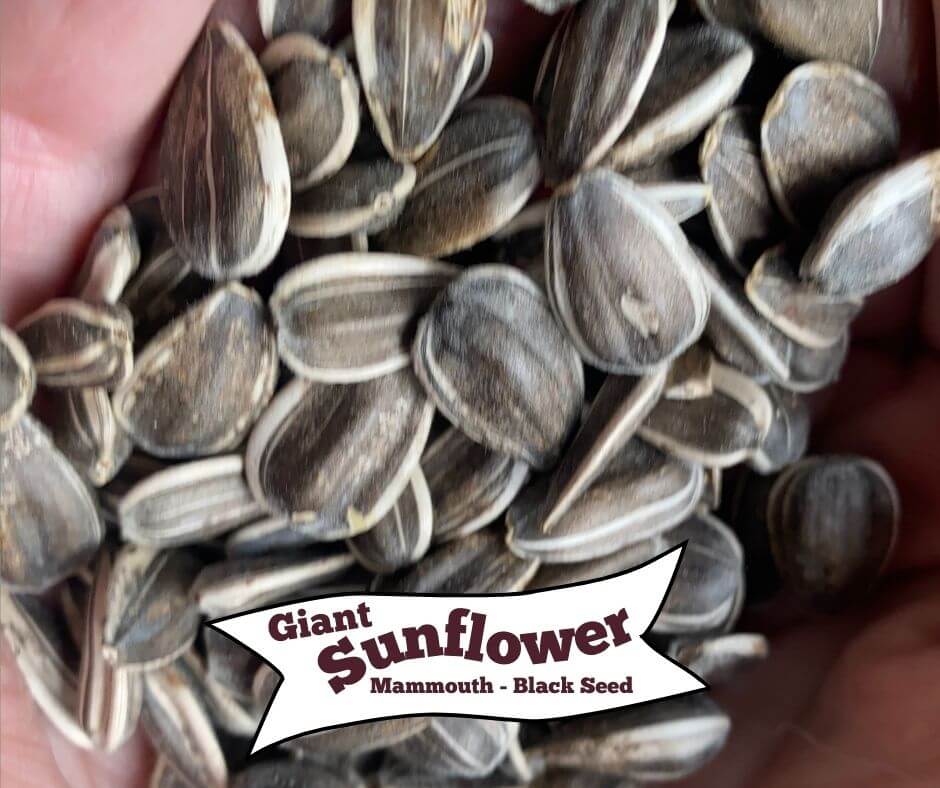
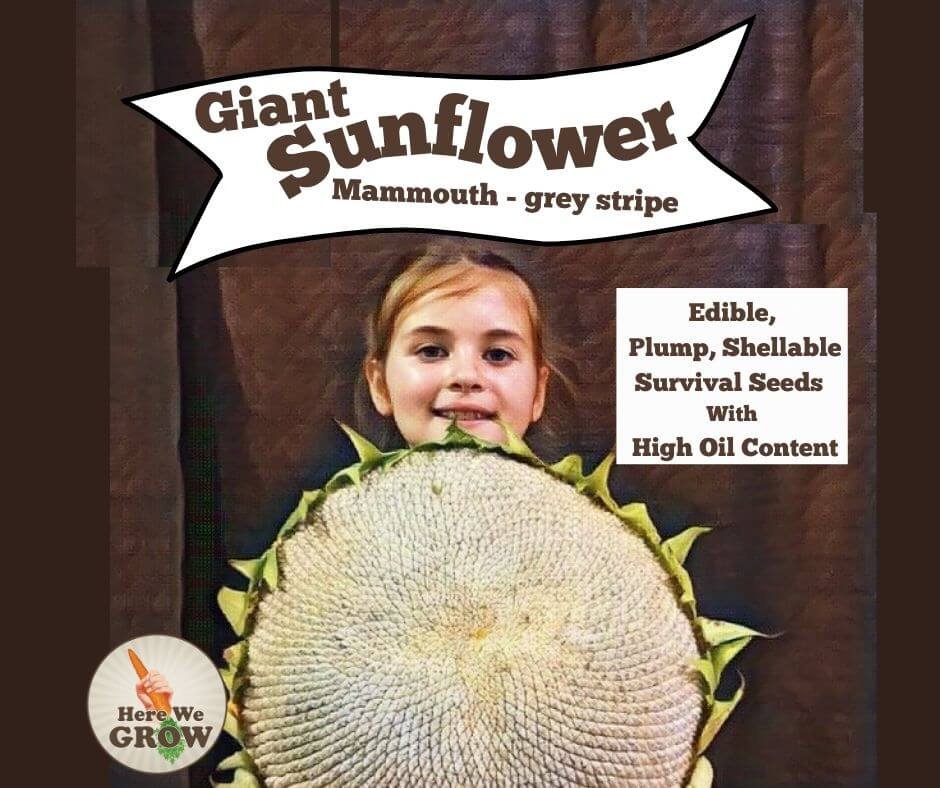
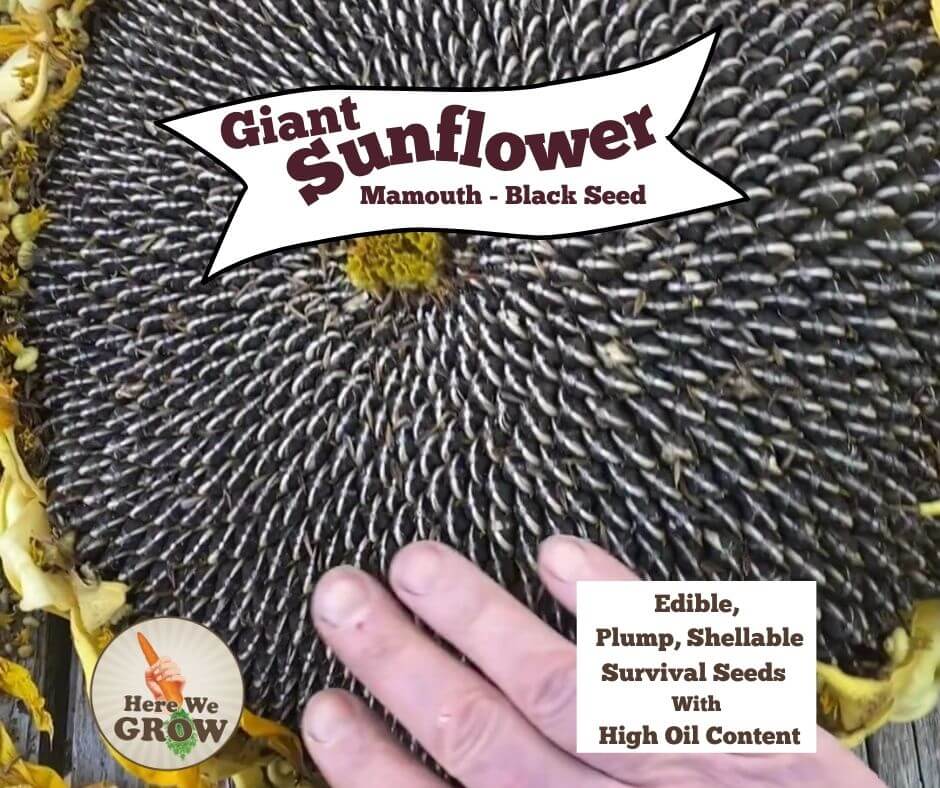
1) Mammoth Grey Stripe – 10-12 feet high 10-12″ heads – Taller with smaller heads https://www.herewegrowgardens.com/product/mammoth-grey-str…edible-sunflower/
2) Mammoth Black Seed – 6-10 ft high -12- 14″ heads – bigger seeds – bigger heads – shorter plants https://www.herewegrowgardens.com/product/mammoth-black-seed-seed-packet-giant-edible-sunflower/
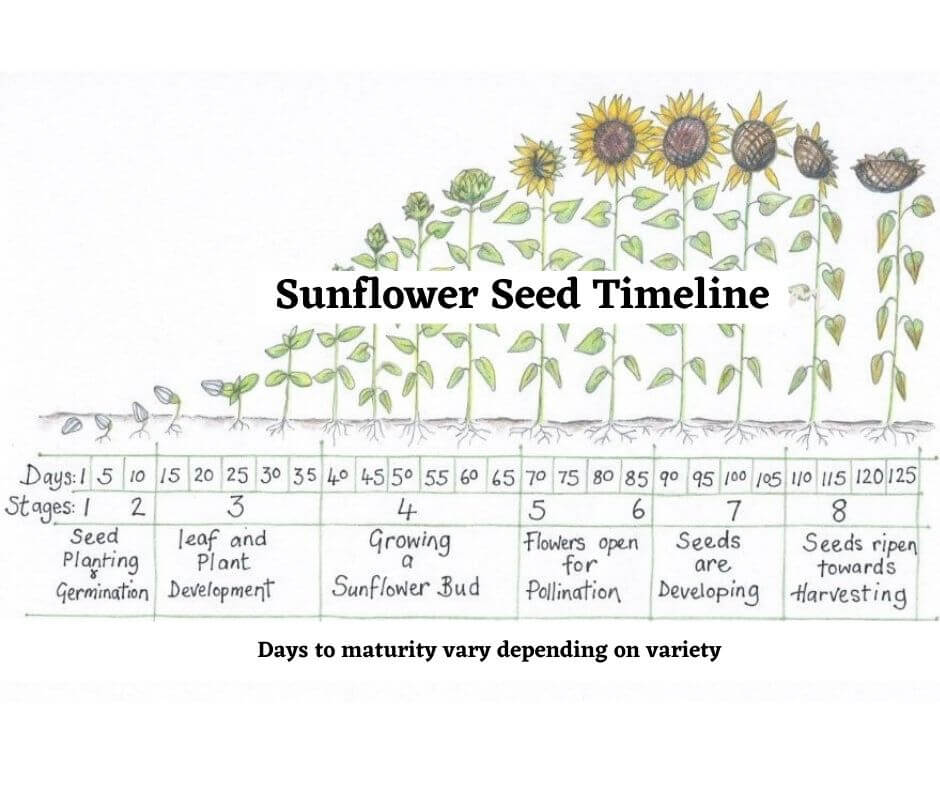
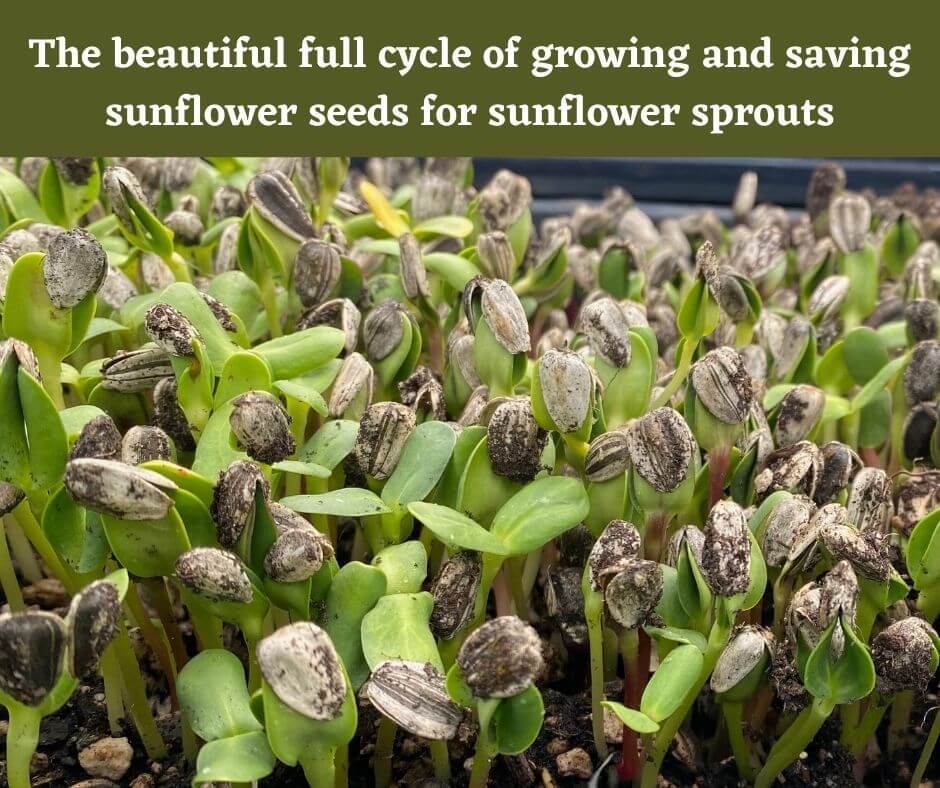
Planting the Sunflower Seeds
When you are planting sunflowers outdoors, make sure you wait to plant them no sooner than two weeks before the last expected frost date. Where I live that’s about May 15th. It’s best to sow sunflower seeds directly into the garden after the danger of spring frost has passed anytime after soils have warmed to at least 50°F (10°C). Although, I do see sunflowers volunteer and make it through the last spring frosts, they really do grow best with warm weather.
Try to plant your seeds directly in the ground if possible rather than planting them in a seedling tray or container. With water and warmth these sunflower seeds should germinate in 7-18 days, The seedlings grow incredibly fast and develop the strongest root system if allowed to grow in place directly from the seed. Sunflowers have a large tap root, which grows quickly. Direct sown Sunflowers tend to grow taller and withstand blowing over than transplanted sunflowers.
If you must starting seeds indoors, they key is to make sure the seedlings do not stay in there pot too long. The appeal of starting sunflowers indoors gives you a head start on getting the sunflowers on there way to making flowers. You can start the sunflower seeds 2-4 weeks earlier than if you are growing them outdoors. I suggest using a 4 inch pot as a minimum size, with 1-2 seeds per pot. The seedlings should only be in the pot for a maximum of 3 weeks. Any longer than 2-3 weeks and the tap root will hit the bottom of the pot and start curling around, which will forever effect the root system of the plant.
Plant Spacing – If you want your sunflowers to get really big and really tall they will need to be at least 12 inches apart at the base. If you are direct sowing the seeds they can be thinned once the seeds are up. If you are transplanting baby plants, I suggest staggering the plants in the row maintaining a space of at least 12′ around each plant.
Water – keep the seedlings moist for the first 6 weeks and then you can taper off the water. Sunflowers are somewhat drought tolerant.Once a established, Sunflowers like long deep soaks instead of daily water. Think of how deep the root must be to be producing such a huge plant.
Sunlight – Mammoth sunflowers need full sun to grow to their full height. They need at least six hours of direct sunlight a day to thrive. However, they grow better/taller with closer to eight hours of direct sunlight.
Staking – Mammoth sunflowers really live up to their name but sometimes they become too tall for their own good. If the plant is in danger of toppling over from its own weight or from a forecasted wind, the plant can be staked with a heavy-duty tree stake.
This central disk is made up of tiny florets that are self-pollinating. As the season goes on, each individual floret will produce one seed in a tough outer hull that is either black or striped. Russian Mammoth sunflowers mature in 75 – 90 days with 12′ stalks and giant heads. Thin-shelled, striped seeds are plump, meaty, and very plentiful.
Ripening the sunflower seeds to maturity Seeds are ready for harvesting when you can visibly see the shell of the seeds throughout the face of the flower and the petals have started to brown. As you wait for the seeds to fully ripen, one of your biggest challenges may be keeping birds and other small critters away after the flower has finished blooming and has started to dry out. They love to snack on the seeds and won’t wait for them to be fully ripe. If you see some seeds missing from the edges, it is time to cover and protect the heads.
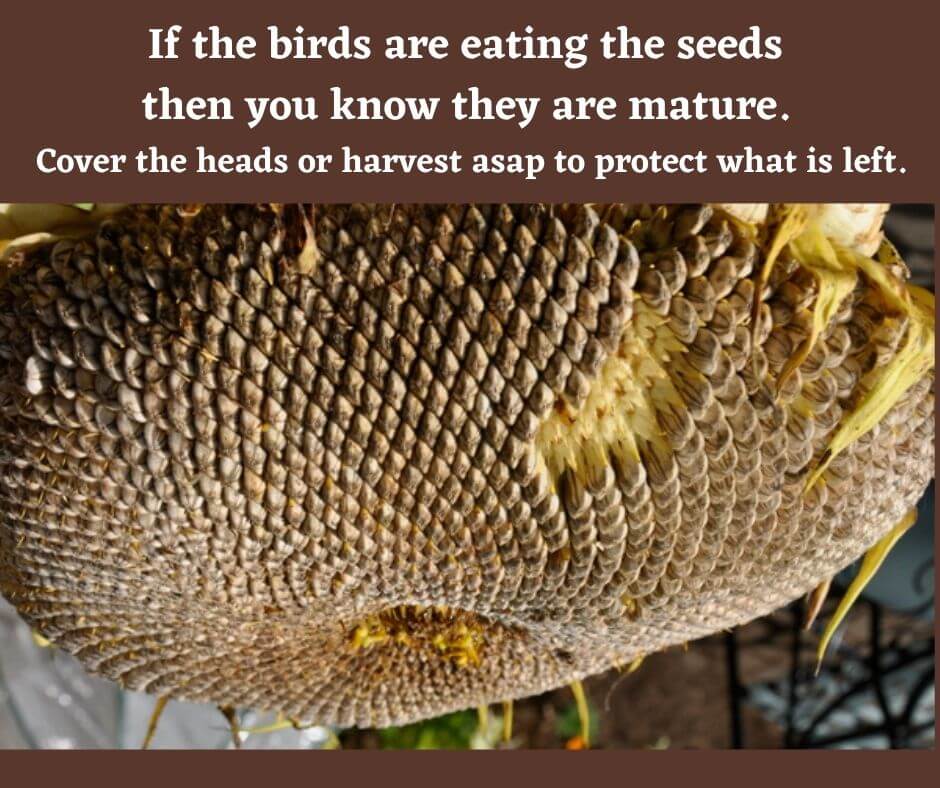
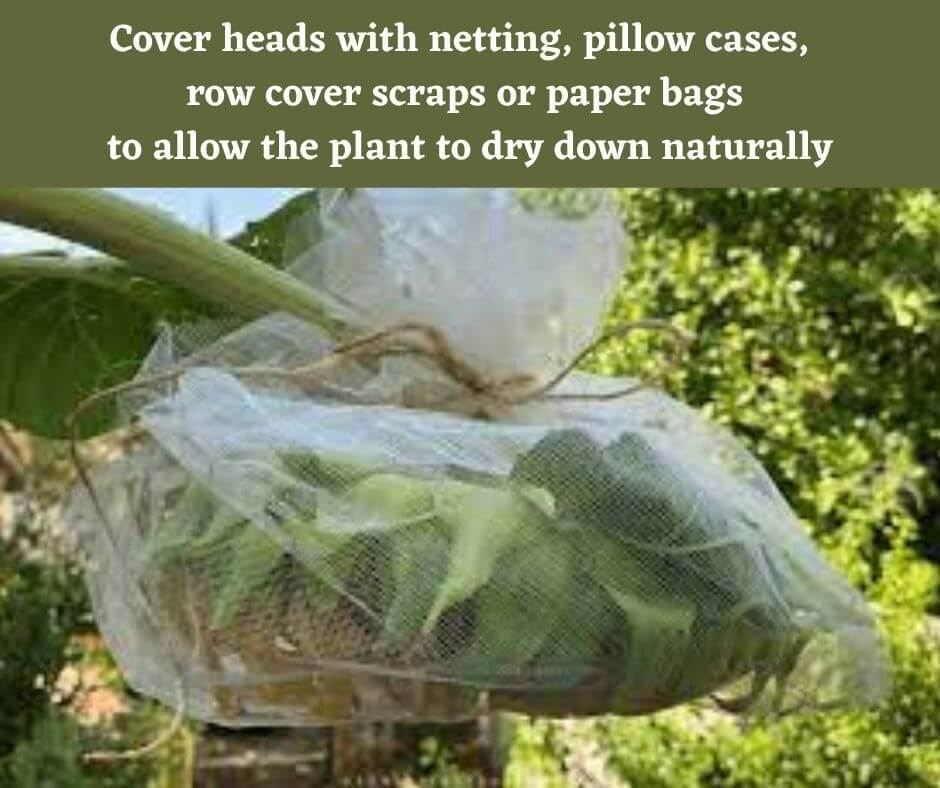
I like to allow the seeds to mature on the plant. I live in Oregon where the fall is dry. The sunflower head will droop and the plant will dry down naturally as the plant finishes it’s cycle. The head will be hard, inflexible and brown when it is dry. I like to place a pillow case or scrap row cover, mesh over the head and secure with a long twist tie, bungee or string. ( i have a collection of pillow cases and ball bungees just for my sunflower heads) You can use a paper bag, but your bag won’t hold up well to rain and wind.
The sunflower heads could be harvested early to protect them, then dried indoors. If you want to harvest the heads earlier, cut them when the back of the head has turned from green to yellow. You’ll need to set up a drying rack with good air flow to put the sunflower heads on. I have had lots of issues with mold when I bring the heads inside to dry so check the heads often. The birds also love to peck at the drying heads if they are in a greenhouse or porch area. Do not put the heads in a box or tote and leave them there. They will get moldy.
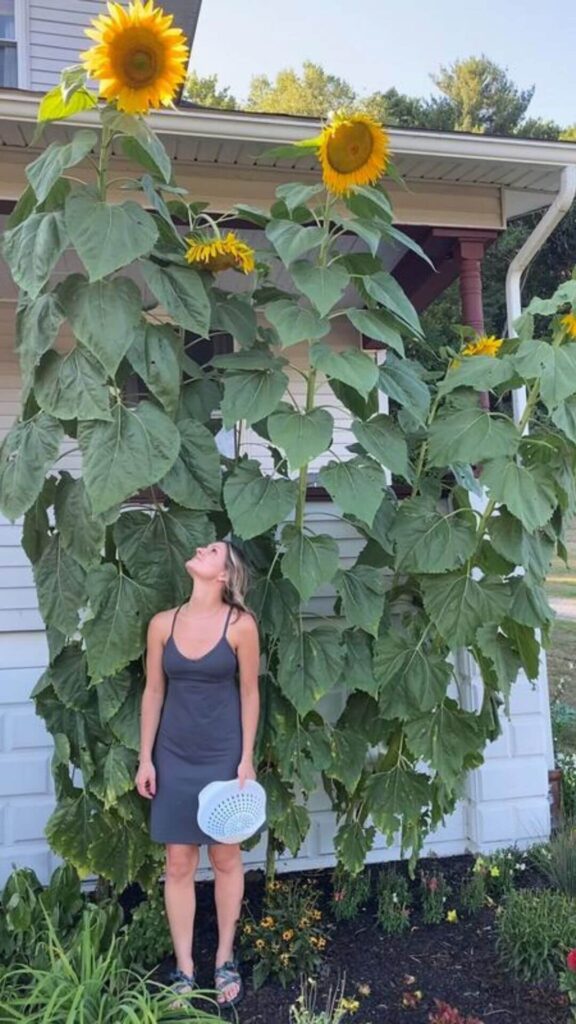
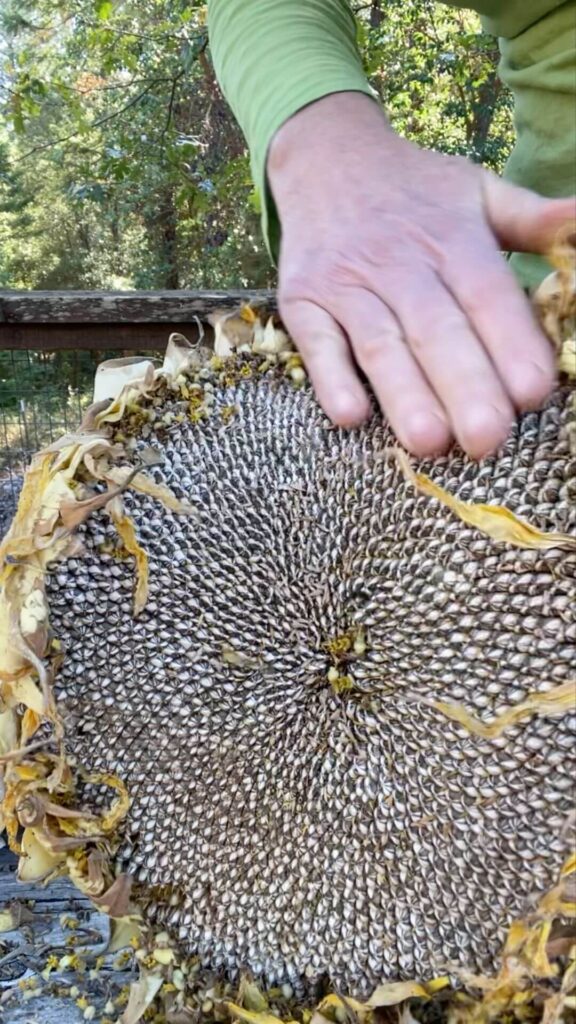
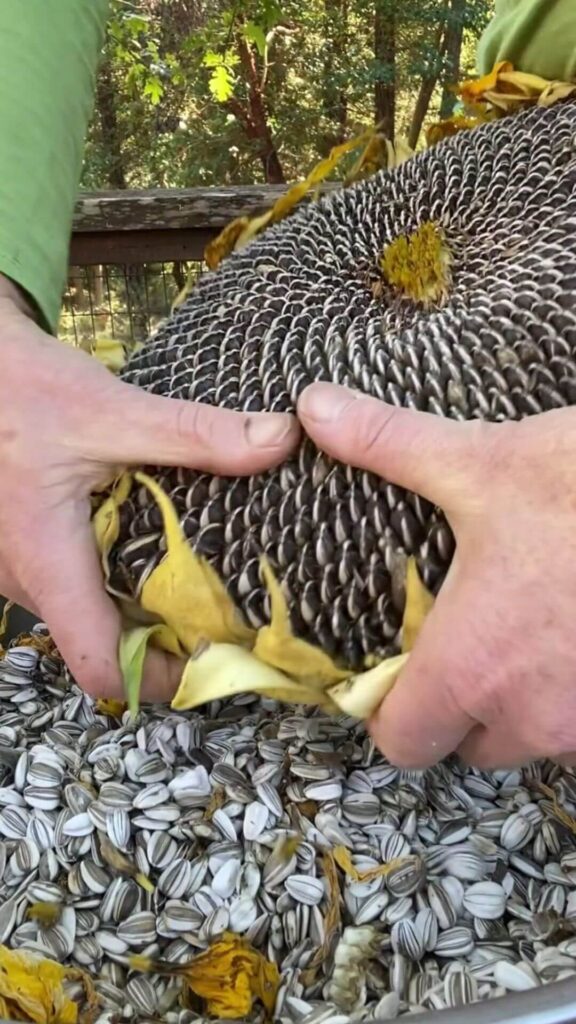
Processing the Seeds – Once the seeds are dry, the fun job of hand rolling the seeds off the head is next. I like to use a large metal bowl to catch the seeds. Using your fingers or a fork, rub the face of the flower over a large bowl, loosening the seeds and allowing them to fall into the bowl. Continue removing seeds until the entire face of the flower has been stripped.
Next, I winnow the seeds with a fan to remove the florets and petals and any light seeds. I then put the seeds on a drying rack for a few days to ensure that the seeds are 100 percent dry before storing the seeds. Now the seeds are ready for roasting and sprouting and eating!
Enjoy!


